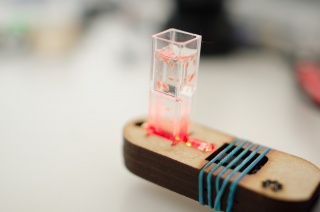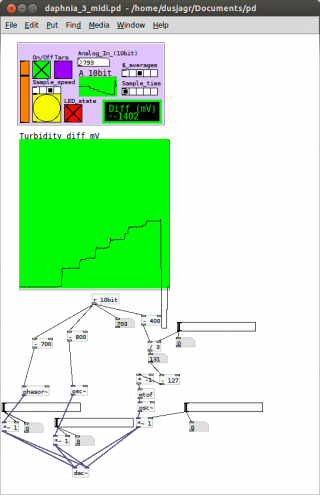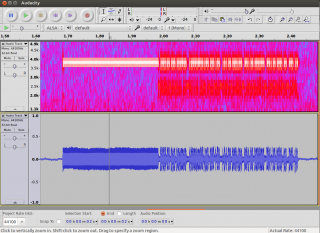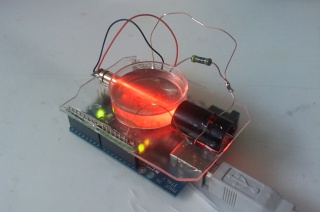DIY turbidity meters
Contents
- 1 Spectroscope
- 2 Turbidity Meters
- 2.1 New TurbiGNUSB by Gaudi Industries & Söhne Inc.
- 2.2 Turbidity Meter made in Germany
- 2.3 BabyTurbiduino aka Nyamuk Synthisaaaiza
- 2.4 Turbidity BugVJ session outside Mačkovica
- 2.5 BabyTurbiduino aka Daphna-2-MIDI Converter
- 2.6 Turbidity meter, visual
- 2.7 Turbidity sensor
- 2.8 some links and snippets
- 2.9 UV-vis absorbtion spectrophotometer
Spectroscope
coming soon, first experiments by Andy and dusjagr and GaudiLabs Open Fiber Spectrometer looked great... see more details on DIY spectroscopy
Turbidity Meters
we started a github repo
New TurbiGNUSB by Gaudi Industries & Söhne Inc.
"It's not REAL open source if it hasn't used a 3-D printer AND a laser-cutter" - anonymous 2015
Turbidity Meter made in Germany
http://www.thingiverse.com/thing:1434139
BabyTurbiduino aka Nyamuk Synthisaaaiza
Pretty much the same as below, just made new designs, larger and easier to produce locally here in Yogya. added speaker and VU meter extension... testing it now!
Download the files here File:MASK Niamuk synthisaaiza.pdf for printing the pcb and the original design File:Niamuk synthisaaiza.zip
Turbidity BugVJ session outside Mačkovica
BabyTurbiduino aka Daphna-2-MIDI Converter
New Design BabyUSB
Prototyping
Kafi-Schnapps Detektor
See more info and file on Thingyverse
Files for Ardunio and pd File:Turby files.zip
Daphnia-2-MIDI device
Some bugs in the cuvette:
Testing different yeast culture densities:
Turbi-2-Audio-SmartPhone interface
Tests with Bengt et al
It woooorks!
we finally soldered a mini-jack plug to go directly into the line-in.... muuuuuch better quality than through the air :-) who would expect that!
We made various tests the other night, trying to have the Baby communicating like a modem, bliip bliip bluup, first using a small piezo-speaker or the hi-fi in the living room. it's looking good:
the free software Sigmira is kinda useful to test http://www.saharlow.com/technology/sigmira/
Bengt had to modify the SoftModem library to work with the attiny85, some different names of the PORTs and TMSKs and experiment with different frequencies for the carrier and baudrates.
you can easily check the signals also with audacity. display as spectrogramm and do spectral analysis.
FSK-Baby
We had to do some changes to the SoftModem library... more soon.
With the following speed setting it works fine, but slow:
#define SOFT_MODEM_BAUD_RATE (50) #define SOFT_MODEM_LOW_FREQ (600) #define SOFT_MODEM_HIGH_FREQ (850) #define SOFT_MODEM_MAX_RX_BUFF (32)
resources
some inspiring links:
http://www.kickstarter.com/projects/lumulabs/lumu-bringing-light-meter-to-the-21st-century
http://www.trendhunter.com/trends/smartphone-wind-meter
http://pinoutsguide.com/HeadsetsHeadphones/samsung_moment_pinout.shtml
http://sree.cc/electronics/arduino-as-an-fsk-modem
http://forum.arduino.cc/index.php/topic,19648.0.html
Interesting article by tom keene about the iPhone boundary, also talking about the SoftModem approach, but finally just going into the phone with an oscillation. http://www.theanthillsocial.co.uk/sites/theanthillsocial.co.uk/files/TheAppleBarrierTomKeene.pdf
http://colinbookman.com/2014/03/23/micio/
SoftModem Library
https://code.google.com/p/arms22/downloads/detail?name=SoftModem-005.zip
http://arms22.blog91.fc2.com/blog-entry-366.html
Schematics: http://www.flickr.com/photos/arms22/4821347734
FSK java script for browsers: https://github.com/NeoCat/FSK-Serial-Generator-in-JavaScript/
more about FSK, Frequency Shift Keying
http://en.wikipedia.org/wiki/Frequency-shift_keying
abnother one
https://code.google.com/p/androino/wiki/AndroinoTerminal
Turbidity meter, visual
Secchi disc
http://youtu.be/LZ9WLnCAd1M?t=54s
Turbidity sensor
simple light absorbtion at a specific wavelength of a cheap laser, easy detection of turbidity.
turbidity to pd tools:
Commercial Turbidity Sensors
see this for dishwashers...
http://www.appliancezone.com/ShowProduct.aspx?ID=48034
http://ch.mouser.com/ProductDetail/GE-MC-Thermometrics/TSW-10/?qs=tktsEd1V4BlbFxHNdxJfvA==
some links and snippets
The Turbidity Module uses an IR LED with a wavelength of 860 nm to meet ISO 7027 requirements for Turbidity water quality measurements.
http://www.turnerdesigns.com/products/laboratory-fluorometer/trilogy-laboratory-fluorometer
UV-vis absorbtion spectrophotometer
UV-vis spectrometer, would be even nicer, added white LED instead of laser, changing colors with simple light filters. but they have almost no UV, so added a UV led. turns out the CdS photoresistors are really slow and not very sensitive at UV also...
also we are working on a hacked line-scanner to look at the spectra after passing a prism or grating.






















